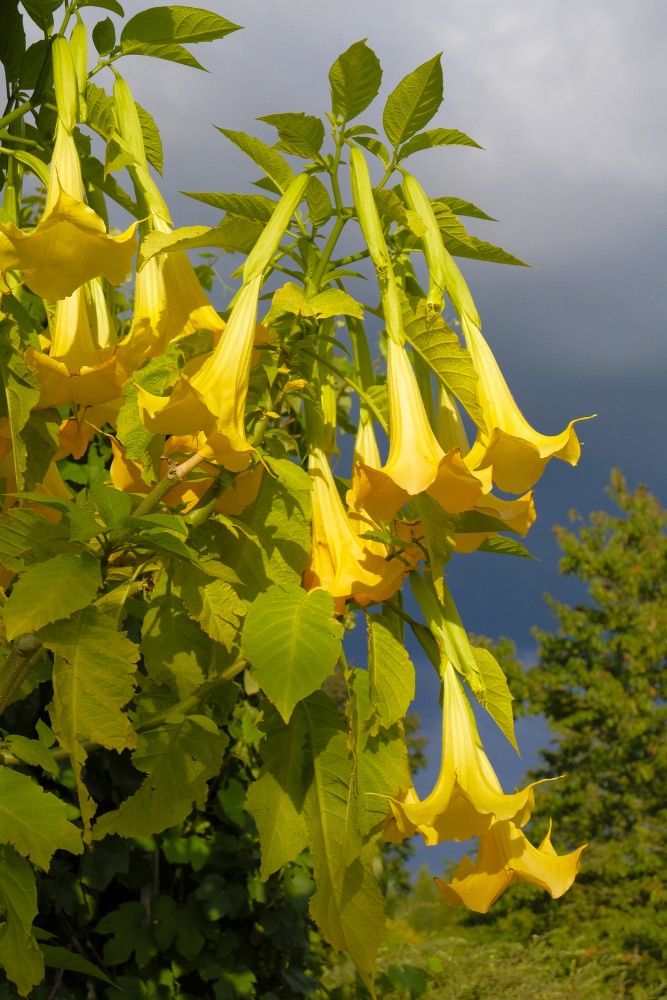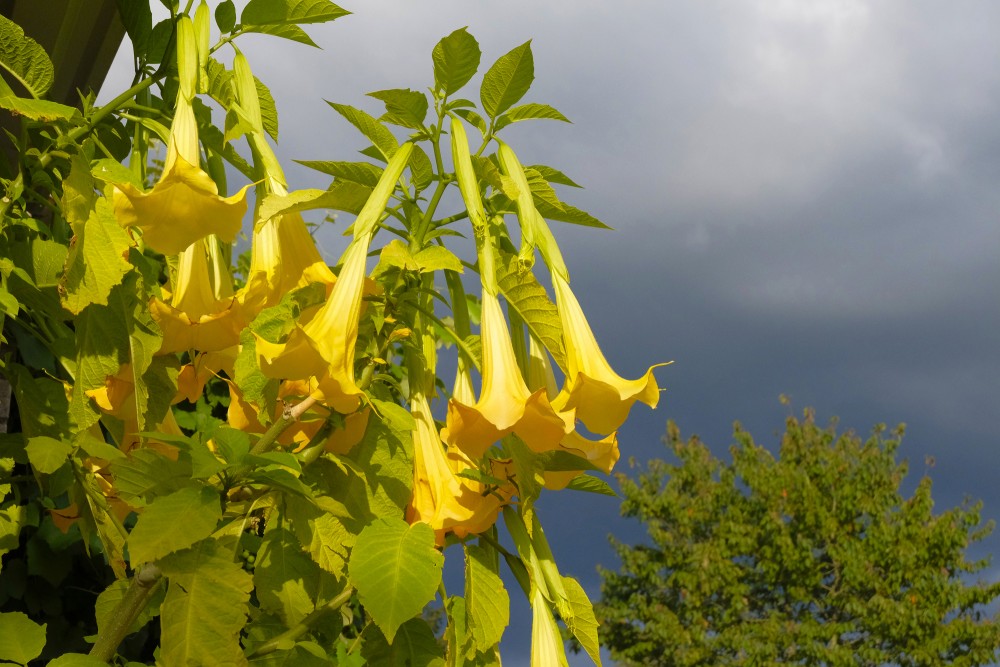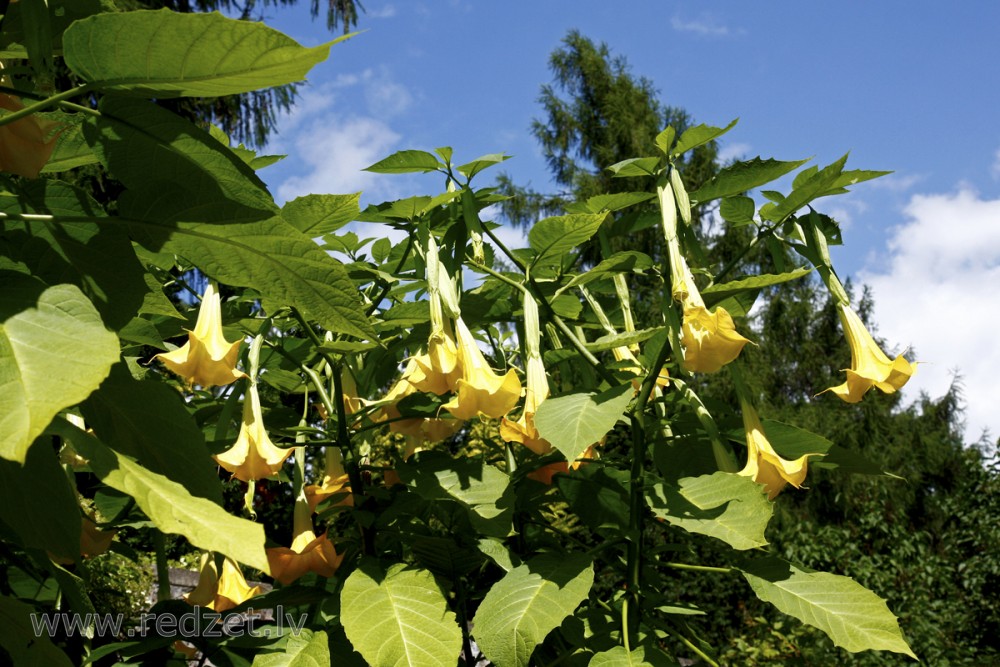(Brugmansia) Angels trumpets
Brugmansia is a genus of seven species of flowering plants in the family Solanaceae. They are woody trees or shrubs, with pendulous flowers, and have no spines on their fruit. Their large, fragrant flowers give them their common name of angel's trumpets, a name sometimes used for the closely related genus Datura. (Datura differ from Brugmansia in that they are herbaceous bushes, with erect rather than pendulous flowers - and most have spines on their fruit).
Like many ornamental plants, all parts of Brugmansia can be toxic. All seven species are known only in cultivation or as escapes from cultivation, and no wild plants have ever been confirmed. They are therefore listed as Extinct in the Wild by the IUCN Red List, although they are popular ornamental plants and still exist wild outside their native range as introduced species. It is suspected that their extinction in the wild is due to the extinction of some animal which previously dispersed the seeds.
Description
Brugmansia are large shrubs or small trees, with semi-woody, often many-branched trunks. They can reach heights of 3–11 m (10–36 ft). The leaves are alternately arranged along the stems, generally large, 10–30 cm (4–12 in) long and 4–18 cm (2–7 in) across, with an entire or coarsely toothed margin, and are often covered with fine hairs. The name "angel's trumpet" refers to the large, pendulous, trumpet-shaped flowers, 14–50 cm (6–20 in) long and 10–35 cm (4–14 in) across at the opening. They come in shades of white, yellow, pink, orange, green, or red. Most have a strong, pleasing fragrance that is most noticeable in the evening. Flowers may be single, double, or more.
Distribution and habitat
Brugmansia are native to tropical regions of South America, along the Andes from Venezuela to northern Chile, and also in south-eastern Brazil. They are grown as ornamental container plants worldwide, and have become naturalized in isolated tropical areas around the globe, including within North America, Africa, Australia, and Asia.
Ecology
Most Brugmansia are fragrant in the evenings to attract pollinating moths. One species lacking scent, the red-flowered Brugmansia sanguinea, is pollinated by long-billed hummingbirds.[3] Brugmansia have two main stages to their life cycle. In the initial vegetative stage the young seedling grows straight up on usually a single stalk, until it reaches its first main fork at 80–150 cm (2.6–4.9 ft) high. It will not flower until after it has reached this fork, and then only on new growth above the fork. Cuttings taken from the lower vegetative region must also grow to a similar height before flowering, but cuttings from the upper flowering region will often flower at a very low height.
One interesting example of plant/animal interaction involves the butterfly Placidula euryanassa, which uses Brugmansia suaveolens as one of its main larval foods. It has been shown that these can sequester the plant's tropane alkaloids and store them through the pupal stage on to the adult butterfly, where they are then used as a defense mechanism, making themselves less palatable to vertebrate predators.
Uses
Brugmansia are most often grown today as flowering ornamental plants.
In modern medicine, important alkaloids such as scopolamine, hyoscyamine, and atropine, found in Brugmansia and other related members of Solanaceae, have proven medical value for their spasmolytic, anti-asthmatic, anticholinergic, narcotic and anesthetic properties, although many of these alkaloids, or their equivalents, are now artificially synthesized.
Brugmansia have also traditionally been used in many South American indigenous cultures in medical preparations and as an entheogen in religious or spiritual ceremonies. Medicinally, they have mostly been used externally as part of a poultice, tincture, ointment, or where the leaves are directly applied transdermally to the skin. Traditional external uses have included the treating of aches and pains, dermatitis, orchitis, arthritis, rheumatism, headaches, infections, and as an anti-inflammatory. They have been used internally much more rarely due to the inherent dangers of ingestion. Internal uses, in highly diluted preparations, and often as a portion of a larger mix, have included treatments for stomach and muscle ailments, as a decongestant, to induce vomiting, to expel worms and parasites, and as a sedative.
Several South American cultures have used Brugmansia as a treatment for unruly children, that they might be admonished directly by their ancestors in the spirit world, and thereby become more compliant. Mixed with maize beer and tobacco leaves, it has been used to drug wives and slaves before they were buried alive with their dead lord.
Toxicity
All parts of Brugmansia are potentially poisonous, with the seeds and leaves being especially dangerous. Brugmansia are rich in scopolamine (hyoscine), hyoscyamine, and several other tropane alkaloids. Effects of ingestion can include paralysis of smooth muscles, confusion, tachycardia, dry mouth, diarrhea, migraine headaches, visual and auditory hallucinations, mydriasis, rapid onset cycloplegia, and death.
The hallucinogenic effects of Brugmansia were described in the journal Pathology as "terrifying rather than pleasurable". The author Christina Pratt, in An Encyclopedia of Shamanism, says that "Brugmansia induces a powerful trance with violent and unpleasant effects, sickening after effects, and at times temporary insanity". These hallucinations are often characterized by complete loss of awareness that one is hallucinating, disconnection from reality, and amnesia of the episode, such as one example reported in Psychiatry and Clinical Neuroscience of a young man who amputated his own penis and tongue after drinking only 1 cup of Brugmansia tea.
The concentrations of alkaloids in all parts of the plant differ markedly. They even vary with the seasons and the level of hydration, so it is nearly impossible to determine a safe level of alkaloid exposure.
Cultivation
Brugmansia are easily grown in a moist, fertile, well-drained soil, in sun to part shade, in frost-free climates. They begin to flower in mid to late spring in warm climates and continue into the fall (autumn), often continuing as late as early winter in warm conditions. In cool winters, outdoor plants need protection from frost, but the roots are hardier, and may resprout in late spring. The species from the higher elevations, in B. section Sphaerocarpium, prefer moderate temperatures and cool nights, and may not flower if temperatures are very hot. Most Brugmansia may be propagated easily by rooting 10–20 cm (4–8 in) cuttings taken from the end of a branch during the summer.
Several hybrids and numerous cultivars have been developed for use as ornamental plants. B. × candida is a hybrid between B. aurea and B. versicolor; B. × flava is a hybrid between B. arborea and B. sanguinea; and B. × cubensis[13] is a hybrid between B. suaveolens, B. versicolor, and B. aurea. There are cultivars producing double flowers, and some with variegated leaves. The cultivar B. × candida 'Grand Marnier' has gained the Royal Horticultural Society's Award of Garden Merit.
en.wikipedia.org
https://en.wikipedia.org/wiki/Brugmansia
Continue reading

